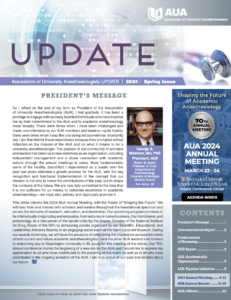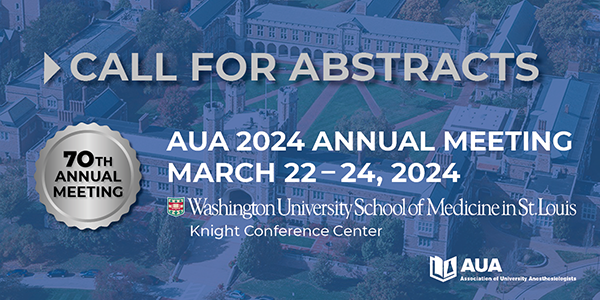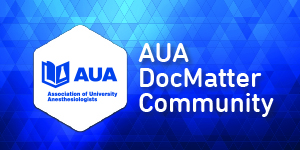The William L. Young Research Award – Remembering an Inspirational Anesthesiology Researcher and Mentor
 The Society for Neuroscience in Anesthesiology and Critical Care (SNACC) honors the legacy of William L. Young, MD with a research award for junior neuroscientists that bears his name. The award, which is presented annually, commemorates a groundbreaking clinician-scientist and role-model who was a longstanding active member of both SNACC and the AUA, and mentor and friend to many.
The Society for Neuroscience in Anesthesiology and Critical Care (SNACC) honors the legacy of William L. Young, MD with a research award for junior neuroscientists that bears his name. The award, which is presented annually, commemorates a groundbreaking clinician-scientist and role-model who was a longstanding active member of both SNACC and the AUA, and mentor and friend to many.
Dr. Bill Young was a pioneer of cerebrovascular research and world-renowned expert on arteriovenous malformations (AVM), who authored more than 340 peer-reviewed publications throughout his career. His ground breaking work transformed our understanding of the pathophysiology of neurovascular disease. He was a visionary who saw that complex questions are best answered by multidisciplinary teams and possessed the skill to bring together diverse groups of scientist bound by a shared passion. He partnered with experts in the fields of neurology, neurosurgery, neuroradiology, molecular biology, bioengineering, and genetics to target questions of cerebrovascular pathology throughout his career. Partnering with researchers from neighboring fields and creating spaces for them to exchange ideas was a pillar of Dr. Young’s success as a scientist and as a mentor. Similarly, he did not allow himself to be bound by the traditional topics of anesthesiology research and dared asked big questions and propose bigger answers. While his early seminal work described the pathophysiology of reperfusion hyperemia after treatment of AVMs, he later expanded his pursuits to define the genetic underpinnings and environmental factors driving biogenesis of vascular malformations. Identifying biomarkers to predict disease progression was a further step on his quest to target the disease itself, rather than improve its management.
Dr. Young attended medical school at Indiana University and completed clinical anesthesia training at New York University Medical Center. After completing clinical and research fellowship training he began his cerebrovascular research at Columbia University. He later moved to UCSF, where he was the James P. Livingston Endowed Chair and Vice Chair for Research in the Department of Anesthesia and Perioperative Care and founder and director of the Center for Cerebrovascular Research. Bill Young was President of SNACC 1996 – 1997. His friends and colleagues often described Dr. Young as a renaissance man, as he exceled at so many seemingly unrelated tasks. In addition to his many academic achievements, he was an accomplished jazz pianist who found time to perform throughout his busy career. Dr. Young served the larger scientific community as a peer reviewer and chair of multiple study sections for the National Institutes of Health and on the editorial boards of multiple journals, including Stroke, Anesthesiology, and the Journal of Neurosurgical Anesthesiology.
Dr. Young was continuously funded by the NIH throughout his career and held multiple independent awards and program project grants. As continues to be the case for many promising anesthesiology researchers, he received an early start with an award from the Foundation for Anesthesia Education and Research. The American Society of Anesthesiologists later honored him with the Excellence in Research Award (2009).
Dr. Young distinguished himself as a mentor and adviser to scores of anesthesiology trainees and junior faculty, many of whom went on to distinguished careers at universities throughout the US and worldwide. He was a mentor on multiple NIH K and American Heart Association scientist development awards and was recognized by the NIH for his substantial mentoring with a K24 award in 1999.
Bill Young believed that anesthesiologists should aim to study the diseases they encounter in order to eliminate them. The William L. Young Neuroscience Research Award established by SNACC in 2016 honors his legacy by supporting promising junior academic physicians and scientist and their projects across the breadth of Neuroscience in Anesthesiology and Critical Care. The inaugural award in 2016 went to Miles Berger, MD, Assistant Professor of Anesthesiology at Duke University, for his research focusing on postoperative cognitive dysfunction and delirium. Dr. Berger currently holds a K76 career development award from NIA for work related to neuroinflammation in postoperative cognitive dysfunction. Andrew E. Hudson, MD, PhD, Assistant Professor-in-Residence at the University of California Los Angeles, received the William L. Young Award in 2017 to support his project investigating burst suppression in the cortical microcircuit. Dr. Hudson received a K08 award from NIGMS to investigate network pertubations: specificity of general anesthetic actions on interneuron supopulations. The most recent William L. Young Award presented in 2018 supports Dr. Umeshkumar Athiraman, Assistant Professor at Washington University, for his investigation of anesthetic conditioning and secondary brain injury after subarachnoid hemorrhage. Dr. Athiraman has also receives research support from the Brain Aneurysm Foundation.
The fund supporting the William L. Young Neuroscience Research Award was initiated with a contribution by SNACC. It has continued to grow through individual donations. The initial awards were limited to $5000 in research support for the recipient. We hope to be able to provide larger awards that offer more substantial support in future years, as additional donations expand the available funds.
Tax deductible donations to the William L. Young Neuroscience Research Award that will support future leaders in neuroscience discovery can be made through SNACC.










